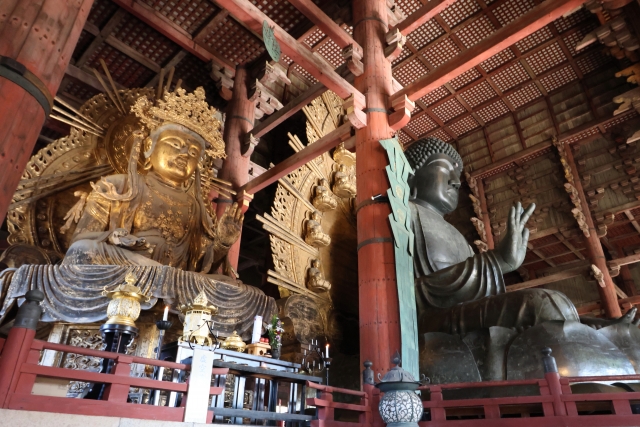About Todaiji Temple
Todaiji Temple is the largest wooden building in the world and has been included in the World Heritage Site. Monk Kanzen of the Tang Dynasty held his ordination here. The current Todaiji Temple has actually been burned down several times, as well as renovated.
Before entering Dongdaesi Temple, you will pass by its South Gate, which is imposing and has Vajra statues on both sides of the entrance. The main hall of the temple is even more magnificent than the south gate, but you need to buy a separate ticket to enter. In the center of the main hall is the Luciana Buddha, which is at least 3 stories high, and on either side of it is the Goddess of Mercy.
Behind the main hall there are two statues of the Heavenly Kings, and a unique large pillar with a large hole, through which many people line up to drill through the pillar, especially local students, led by their teachers one by one. I guess there is some kind of symbolic meaning.

How to get there
From JR Nara Station or Kintetsu Nara Station, take a city bus and get off at Daibutsu-den Kasuga Taisha-mae (Daibutsu-den Kasuga Taisha-mae) stop, which is a 5-minute walk.
From Kintetsu Nara Station, it is also a 20-minute walk.
Fare
Jan. 1-Dec. 31 Mon.-Sun.
Adult: Grand Hall 600 yen / Grand Hall + Museum 1,000 yen
Child: Grand Hall 300 yen / Grand Hall + Museum 400 yen
Tips
There are also many deer in Todaiji Temple, so please pay attention to your own safety when feeding the deer cake to avoid being hurt by the deer’s top, kick or bite, and you can also see the notice about this in the temple. In fact, the deer here have been assimilated by tourists very seriously, grabbing people’s food often happens. Todaiji Temple is a fee, free of charge when entering, but to visit the temple itself is charged.
Entering the door on the left and right, the two guardians, on this is also a national treasure.
in fact, this in Jiuhua Mountain and other mountains have seen many times, perhaps this age longer, the temple is all wooden structure, it is recommended that what ails the body, you can go out and touch the left hand side of the Bodhisattva statue, it is said that where the pain, touch where, you can control the corresponding department, lift the pain ~ the so-called Lu Shena Buddha, is in accordance with the image of Wu Zetian Shaped, in the Woongong Longmen Grottoes, there is the highest level of art, the most rigorous overall design and the largest scale.
The suggested path for touring Dongdaesi Temple is to enter the hall and tour to the left to see an introduction about the history and some artifacts of Dongdaesi Temple, then walk to the right rear of the hall and you will probably see the feature of Dongdaesi Temple, a big pillar ~ many people lined up, what are they doing? They were waiting to go through a small hole underneath the pillar, and although there was a hole and the pillar was very old, it still served as a support for the main hall. As a slightly claustrophobic person, I’d rather not try it.
If you are not very fat and not afraid, you can actually still try. At the right hand side of the exit of the main hall, we went to try fortune slip, this time I was able to draw a big yoshi. I originally thought that this place was not a bluff, it was all big yoshi, but then I saw the queue of people, there were many yoshi and end yoshi, and I started

Todaiji Temple was particularly crowded with visitors, and had the largest traffic of any temple we visited in the past few days. A large number of deer wandered around the entrance, coveting the deer cakes in the hands of visitors. The main gate of the temple, the South Gate, is also a World Heritage Site. The entrance fee is 500 yen for the Great Buddha Hall, the largest surviving wooden structure in the world, and the hall houses the over 15-meter-tall Vishnu Shakyamuni Buddha, the largest bronze statue of Buddha in Japan. More than half of the visitors are local students. Many students line up to drill the small holes under the pillars inside the temple, and it is said that those who can successfully drill through them will have good luck. The window panel above the Great Buddha Hall can be opened and the Buddha statue can be seen at the entrance of the courtyard after opening. Turn left out of the Great Buddha Hall and then turn left uphill to the second, third and fourth hall.
It’s a 15-minute walk from Kintetsu Nara Station, and it’s very close, but there are a lot of tourists and deer. The deer here often come into contact with tourists, so they are more bold and relatively savage, so remember not to tease too much when feeding them, or they will be easily bitten or topped.
There are many things to see in Dongdaesi, for example, the South Gate itself is a national treasure, but is overlooked by many tourists, and is still built by our Chinese craftsmen, with the shadow of the Southern Song Dynasty architecture. Secondly, there is the Great Buddha Hall, which was restored in the 18th century, but is still the largest wooden structure in the world in terms of volume and is very magnificent. Visit: 500 yen
Website